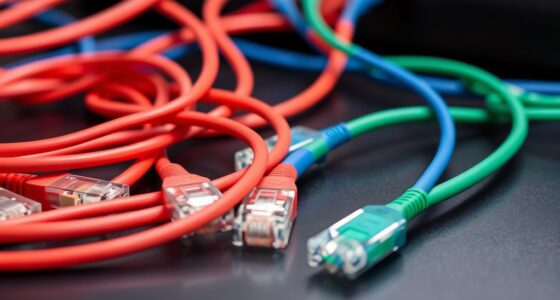Cable coating protects your cables from environmental damage, ensuring safety and durability. PVC coatings are affordable, flexible, and resistant to chemicals, but they release toxic fumes and smoke when burned, making them less ideal for confined spaces. LSZH coatings produce minimal smoke and no halogen gases during a fire, offering safer environments and being more eco-friendly. To understand how these differences impact safety and environment, keep exploring the features of each coating type.
Key Takeaways
- Cable coatings are protective layers that enhance durability, flexibility, and environmental resistance of electrical cables.
- PVC coatings are cost-effective, durable, and resistant to chemicals but emit toxic fumes when burned.
- LSZH coatings produce minimal smoke and no halogen gases during fires, improving safety in enclosed spaces.
- PVC’s environmental impact includes difficulty in recycling and potential release of harmful dioxins during disposal.
- LSZH coatings are more environmentally friendly, offering safer fire behavior and lower long-term ecological footprint.

When choosing cable coatings, understanding the differences between PVC and LSZH is essential for ensuring safety and compliance. Both materials serve as protective layers for electrical cables, but they differ markedly in their fire safety features and environmental impact. Your choice can influence not only the safety of the installation but also its impact on the environment and regulatory adherence.
PVC, or polyvinyl chloride, is a common and cost-effective cable coating material. It offers good durability, flexibility, and resistance to chemicals and moisture, making it suitable for a wide range of applications. However, in terms of fire safety, PVC has notable drawbacks. When it burns, it releases dense, toxic smoke containing hydrochloric acid and other hazardous fumes. This can pose serious health risks during fire incidents, especially in enclosed spaces. As a result, PVC coatings are often restricted or require additional fire safety measures in certain environments, such as public buildings or tunnels. From an environmental perspective, PVC has a notable impact. The production process involves chlorine, and disposal can release harmful dioxins if not managed properly. Recycling PVC is also challenging, leading to concerns about long-term environmental sustainability.
On the other hand, LSZH, or Low Smoke Zero Halogen, coatings are designed explicitly to address fire safety concerns. They produce minimal smoke and virtually no halogen gases when exposed to fire. This makes them ideal for confined or enclosed spaces, where smoke inhalation and toxic fumes could be be life-threatening. Choosing LSZH coating considerably reduces the risk of smoke inhalation, aiding in safer evacuations and firefighting efforts. Additionally, LSZH materials have a lower environmental impact during both production and disposal. They do not contain halogens that can release harmful gases upon burning, which means they produce less toxic smoke and are more environmentally friendly. Many industries now prefer LSZH coatings for their commitment to safety and sustainability, especially in public transportation, data centers, and indoor environments. Moreover, advancements in fire safety technology continue to improve the performance and availability of LSZH materials.
Frequently Asked Questions
How Does Cable Coating Impact Overall Fire Safety?
Cable coating markedly impacts fire safety by providing a protective layer that can prevent or slow ignition. The coating’s effectiveness determines how well it resists flames, smoke, and heat during a fire. PVC coatings are durable but may produce toxic fumes, while LSZH coatings offer enhanced fire safety by minimizing smoke and toxic gases. Choosing the right coating enhances overall fire safety, reducing risks and improving evacuation chances during emergencies.
Are There Environmental Benefits to LSZH Coatings?
Yes, LSZH coatings offer environmental benefits by reducing toxic emissions during fires, helping protect your surroundings. They also have a lower environmental impact due to their non-halogen content. However, recycling challenges arise because LSZH materials are more difficult to process and recycle compared to traditional PVC coatings. You benefit from safer, cleaner options, but you should also consider these recycling hurdles when choosing LSZH coatings for your cables.
Can PVC Coatings Be Recycled Easily?
PVC coatings can be recycled, but recycling challenges exist due to contamination and complex processing requirements. You might find eco-friendly alternatives like LSZH coatings more sustainable since they produce less toxic fumes and are easier to recycle. If you’re seeking environmentally responsible options, consider these alternatives to reduce your ecological footprint and guarantee better disposal practices, making your cable management both effective and eco-conscious.
What Are the Cost Differences Between PVC and LSZH Coatings?
Think of PVC and LSZH coatings as two different vehicles on a journey—one is more budget-friendly, while the other offers extra safety. PVC coatings generally cost less upfront, making installation expenses lower, but LSZH coatings tend to be pricier due to their specialized fire-resistant properties. When considering cost considerations, you balance initial expenses with long-term safety benefits, ensuring you choose the coating that best fits your project’s budget and safety needs.
How Do Coating Materials Affect Cable Durability?
You’ll notice that coating materials directly impact cable durability through their insulation properties and flexibility enhancement. PVC offers strong insulation, protecting against moisture and mechanical damage, making it durable in harsh environments. LSZH coatings provide excellent fire resistance, reducing smoke and toxic fumes. Both materials improve flexibility, which prevents cracking and breaking over time. Your choice depends on your environment and safety requirements, but selecting the right coating guarantees longer-lasting, resilient cables.
Conclusion
Think of cable coatings as the shields guarding the flow of your digital world. PVC is like a sturdy armor, reliable but with some sparks of risk inside. LSZH, on the other hand, acts as a silent guardian, burning away without a trace, symbolizing safety in the shadows. Choosing between them is like selecting a protector for your network’s heartbeat—whether you prefer the familiar strength or the quiet promise of safety, your decision shapes the future of your connection.









